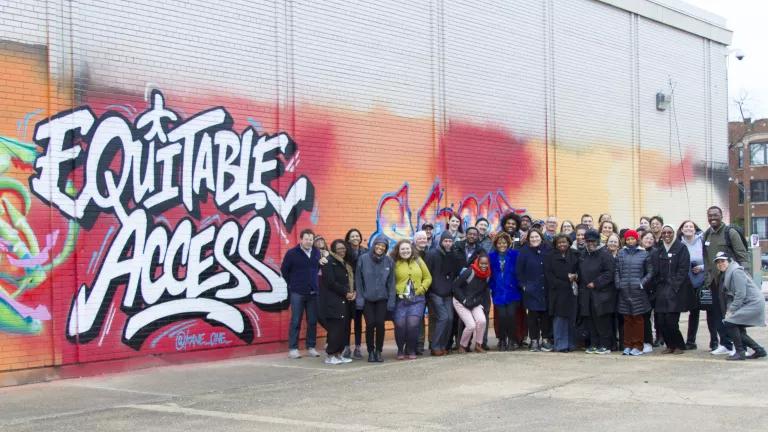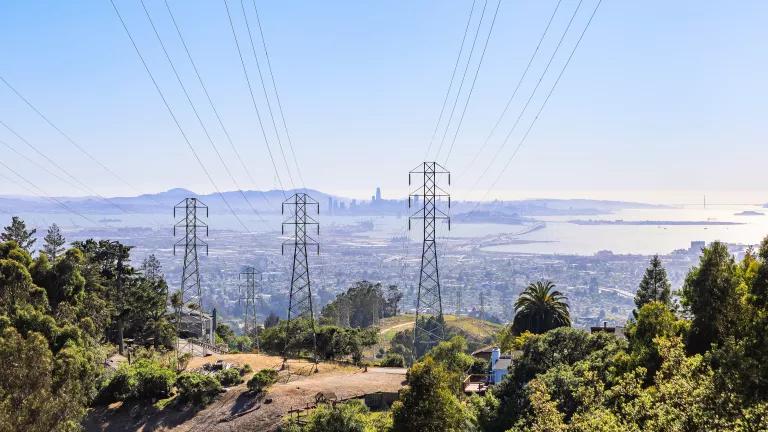We Need to Amp Up the Grid—Now
Most people believe the United States has a power grid that stretches from coast to coast. But the reality is that we have a patchwork of local and regional grids run by many different utilities. The limited “interregional” transmission lines connecting these together are not nearly enough.

Part of NRDC’s Year-End Series Reviewing 2021 Climate & Clean Energy Developments
In February 2021, Texas’ power infrastructure buckled during a week-long cold snap. More than 4.5 million people lost power during Winter Storm Uri, leaving many Texas residents with no heat during days of freezing weather. At least 210 people lost their lives. The storm and resulting outages were responsible for $195 billion in damages to the state’s economy.
While there were many factors, especially the failures of the state’s gas resources to function properly, the storm highlighted a key issue facing our nation’s electric grid: We need more and better transmission lines so that our electric grid is more nimble, resilient and reliable.
This past year, the Federal Energy Regulatory Commission began a process to rework its rules so that we can get needed changes to the grid; next year it will need to finish the job and start implementing those reforms so that we can build the grid we need for the future.
The reasons are clear. Without the ability to move large amounts of electricity from one region to another, keeping the lights on during increasingly frequent severe weather events is becoming more and more difficult. As the example in Texas demonstrates, the inability to do this can have devastating consequences.
Unfortunately, FERC faces strong opposition from commercial interests that profit from our inefficient grid, profit that comes at the cost of higher electric bills, dirtier power, and, at worst, lives lost. It’s time for our regulators to stand up for a stronger grid, more resilient power supply and cleaner, cheaper power options. They can’t give in to powerful, incumbent interests.
Why Interregional Connections Matter
During Winter Storm Uri, Texas’s neighboring states were able to weather the storm without such devastating losses. One key reason is that they could all import power from around the country, saving billions of dollars and possibly lives. Texas, on the other hand, has chosen to isolate itself from other transmission grids. As a result, it couldn’t import power from nearby regions during this emergency, leaving citizens in the cold.
While Texas was uniquely vulnerable due to its isolation, other parts of the U.S. don’t have nearly enough interregional transmission lines to efficiently move electricity to where it needs to go. As my colleague John Moore points out, FERC, which oversees the transmission system, declined to mandate interregional planning when it had the chance to do so ten years ago. As a result, virtually no interregional projects have been built since that time.
FERC has a chance to correct that error with its new rulemaking which seeks to improve the transmission planning process. In order to build a stronger, more resilient grid, it should require regions to work together to plan these projects, helping to usher in the modern grid we desperately need.
How to Improve Interregional Planning
There are many benefits to building interregional transmission. This is especially true during severe weather events. One study found that during the Bomb Cyclone cold snap in 2017-18, Eastern states could have saved $30-40 million for each gigawatt of stronger transmission. And while there is a cost to build these projects, blackouts come with their own costs—both in economic terms and in lives lost.
A broad coalition of environmental groups, including NRDC, have weighed in on how FERC can ensure that these interregional transmission lines get built:
- At the very least, require interregional planning. Right now, utilities manage their own fiefdoms for their own purposes with no coordination with neighbors. It’s like the era before the interstates, when it took more than two weeks to make it across the country via county roads and state highways.
- Even better, create a national planning authority to ensure active cooperation between regions and truly independent planning.
- Implement a requirement for regions to meet a portion of the resources they need to meet demand from outside the region. Regions will need to demonstrate firm transfer capacity to deliver and accommodate those resources, thus guaranteeing their ability to receive and deliver power from other regions.
- Plan for future generation and new demands like electric vehicles, while also preparing for extreme weather. Planners must consider changing technology and show how they’re preparing for possible future risks.
- Require utilities to plan for transmission to meet the laws they must follow and the public statements they’ve made. Utilities must comply with federal, state, and local climate and clean energy requirements. And they make public statements about energy procurement in the form of promises to their shareholders, SEC filings, filings to state agencies, and power purchase contracts. But these are not currently factored in to how they plan transmission.
- Be bold. Today’s rules encourage a hodgepodge of small projects with no particular direction. We need to reverse this and first consider major projects that benefit from economies of scale and serve millions. Once this is done, we’ll find it much less expensive to meet remaining local needs. Most people try not to make a separate trip to the store for every item on their shopping list. It’s common sense that planning our power grid should be at least this efficient.
We now live in a world impacted by climate change. Extreme weather is likely to happen more often and be more intense. We need electric infrastructure that is ready for this. Comprehensive interregional planning can save money on electricity bills, avoid preventable damage, ensure energy reliability, support renewable energy growth, and even save people’s lives.
This year FERC began the process of setting up the grid we need for a climate-impacted world. Next year, FERC should finish the job – setting rules to prepare for the future and fix the system with sensible solutions. Given what we’ve seen, there’s no time to waste. Let’s get to work building the grid we know we need.


